
POLLINATORS | PG. 20
Easter Egg Hunt
VOL. 58 No. 3 MAY 2024
2 CONTENTS Editor's Note + Swinomish Village Street Light Upgrades 3 Public Health: HPAI A(H5N1) - Bird Flu 5 Indigenous Civil Rights Documentary FISH WAR to Premiere at SIFF 7 Swinomish Considering Enhanced Sentencing In Tribal Court 8 Larsen Visits didg wálič 11 Deputy Attorney General Meeting 12 Swinomish Teacher Certification 13 Update #21 Olympic Pipeline gasoline spill Conway, WA 14 Salmon in the Classroom 16 Fitness + Community = Lifestyle Medicine 17 Nourishing A Dream 18 Tending The Garden 19 Pollinators 20 26th Annual National Indian Realty Awards + Air Quality Awareness 26 Weaving + Swinomish Receives Large Climate-Flood Resilience and Salmon Habitat Grant Award 28 Education Dinner for K-5th Grade 30 Free Hair Cuts 31 Easter Egg Hunt 32 Registered Sex Offenders Residing within the Swinomish Community 34 Excluded From the Swinomish Reservation 35
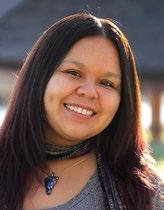
This spring issue includes information about the Tribal Law and Order Act, the Opioid Public Emergency, Swinomish Teacher Certification, Mental Health Awareness Month, Air Quality Awareness Week, and a feature on pollinators.
May is Mental Health Awareness Month
The times we are living in are not easy. We are faced with something new every day. Remember to take time for yourself. Read a book, work out, go on a walk, write in a journal, write a poem or song, photograph something, bead, sew, knit, draw, paint, cook, meditate. Revitalize your mind, tomorrow is a new day.
Upcoming Events
The Blessing of the Fleet is Thursday, May 16 see details on PAGE 6; the DEP: Environmental Learning Series is Wednesday, May 15 see PAGE 29.
I hope you enjoy reading the spring issue of qyuuqs News.
Caroline Ammons goliahlitza
SWINOMISH VILLAGE STREETLIGHT UPGRADES
SUBMITTED BY SWINOMISH LAND MANAGEMENT
Have you noticed the Village is a bit brighter these days?
A total of 31 streetlights in Swinomish Village received upgrades to brighter, more energy efficient LED light sources at the end of March! The new lights should improve visibility with the bonus of reducing energy consumption and costs. Upgrades were made on portions of Front Street, Second Street, Solahdwh Lane, Swinomish Avenue, Keeah Lane, Avenue A, and Squi-Qui Lane.
While the effort to upgrade the streetlights initially started as a renewable energy measure, a request from the Swinomish Police Department to improve lighting for public safety reasons helped prioritize this project and make it a reality. While many were involved in this project, special thanks go out to the Swinomish Police, Legal, and Land Management departments.



3 editor’s NOTE
TRIBAL SENATE
yal le ka but
Steve Edwards, Chairman (360) 840-5768 | sedwards@swinomish.nsn.us
siwelce?
Alana Quintasket, Vice Chair (360) 302-0971 | aquintasket@swinomish.nsn.us
ya qua leous e
Brian Porter | Secretary (360) 840-4186 | bporter@swinomish.nsn.us
taleq tale II
Barbara James | Treasurer (360) 391-3958 | bjames@swinomish.nsn.us
qws stania
Aurelia Bailey (360) 853-6376 | awashington@swinomish.nsn.us
sapelia
Sophie Bailey (360) 853-6458 | sbailey@swinomish.nsn.us
spi sta yup ton
Greg Edwards (360) 854-8612 | gedwards@swinomish.nsn.us
yellakabol
Bruce James Jr. (360) 708-5779 | brucejames@swinomish.nsn.us
sa-ba-shal-good
Rodney John (360) 708-1387 | rjohn@swinomish.nsn.us
kuts bat soot
Jeremy Wilbur (360) 770-7447 | jjwilbur@swinomish.nsn.us
kani?ted
Tandy Wilbur (360) 770-3050 | tandywilbur@swinomish.nsn.us
The
official news publication of
the Swinomish Indian Tribal Community
The mission of qyuuqs News is to provide monthly communication to Swinomish Indian Tribal Community Members near and far. We are committed to serving as an apolitical forum for the Swinomish governing officials and all Community Members. qyuuqs News is not intended to reflect the official position of the governing body at Swinomish Indian Tribal Community but rather reflects the ideas, events, and thoughts of individual Community Members and Tribal staff. As such, the Swinomish Tribe makes no claim as to the accuracy or content of any of the articles contained therein.
QYUUQS MAILING ADDRESS
17337 Reservation Road, La Conner, WA 98257
Phone (360) 466.7258
*SUBMISSIONS
Send your news tips, stories, and photos to: qyuuqs@swinomish.nsn.us
Submission deadline: 10th day of the month
QYUUQS NEWS
Caroline Ammons, Editor qyuuqs@swinomish.nsn.us
SWINOMISH COMMUNICATIONS
Heather Mills, Communications Manager
Sarah Kellogg, Content Journalist
Katie Bassford, Staff Photographer
Jordan Ekdahl, Graphic Designer Communications@swinomish.nsn.us
ADVISORY COMMITTEE
Tracy James, John Stephens, Kevin Paul
This issue is available online at swinomish-nsn.gov/qyuuqs
Photos credits: qyuuqs News Staff or as credited. All rights reserved.
Facebook: Swinomish qyuuqs News
Linkedin: Swinomish Indian Tribal Community
*qyuuqs News is made available for viewing on the Internet
When submitting information, stories, and/or photos, please be aware everything published in the print version of qyuuqs News is also published on the Internet and is available to the world. Please consider carefully whether your submissions contain anything you feel may not be suitable or appropriate for the Internet. By submitting your information, stories, and/or photos to qyuuqs News, you agree to publishing your submission in both the print and online versions of qyuuqs News.
Website: swinomish-nsn.gov
@SwinomishSenate
qyuuqs News is a publication of the Swinomish Indian Tribal Community produced by Swinomish Communications.
4
PUBLIC HEALTH
SARAH WILBORN, SWINOMISH HEALTH SERVICES
HPAI A(H5N1) – Bird Flu
The CDC issued a public health alert regarding recently detected highly pathogenic avian influenza ‘HPAI’ A(H5N1) virus found in some dairy cattle and wild birds in multiple states.
There has been one case of this avian influenza A(H5N1) virus infection (also known as bird flu) detected in a dairy farm worker, who was exposed to a sick cow in Texas on March 27. The patient’s only symptom was conjunctivitis. They were treated with anti-viral medication and are recovering well. There have been no additional reported cases of human infections and no human-to-human transmissions of HPAI A(H5N1) virus have been identified.
“The current risk these viruses pose to the public remains low. However, people with job-related or recreational exposures to infected birds, cattle, or other animals are at higher risk of infection and should take appropriate precautions…” cdc.gov/flu/avianflu/hpai/hpai-interimrecommendations.html#recommendations-farmers

5
Recent Swinomish Indian Tribal Community Code Amendments
BRIANA PORTER, OFFICE OF TRIBAL ATTORNEY
The Swinomish Senate, the governing body of the Swinomish Indian Tribal Community, recently enacted the following code amendments:
Title 17, Chapter 11 – Trust Improvement Use and Occupancy Tax
At the February 2024 Senate meeting, the Senate made revisions to the Tribe’s Trust Improvement Use and Occupancy Tax Code. The revisions amends Exemptions to remove the sliding scale and revert to a single exemption rate as well as amends the types of financial documents required for calculating exemptions. The Tax Committee recommended the amendment, which the Senate enacted on February 8, 2024.
Title 10, Chapter 12 – Communicable Disease
At the February 2024 Senate meeting, the Senate made revisions to the Tribe’s Communicable Disease Code. The amendment requires reporting of certain notifiable conditions of public health importance, and expands the delegated authority of the Public Health Officer to receive such reports. The Tribal Public Health Team recommended the amendment, which the Senate enacted on February 20, 2024.
Title 4, Chapter 1 and Chapter 10 – Preliminary Provisions; Offenses Involving Controlled Substances
At the March 2024 Senate meeting, the Senate made revisions to the Tribe’s Preliminary Provisions, and Offenses Involving Controlled Substances Codes. The revisions expand the Good Samaritan law to serve as an effective public health measure to encourage individuals to call for medical assistance when a person is experiencing an alcohol or drug-related overdose. The Tribal Public Health Team recommended the amendment, which the Senate enacted on March 19, 2024. The amended code and Constitution are available for review on the Swinomish website at swinomish-nsn.gov. Paper copies are available for review at the Tribal Court Clerk office or the Office of the Tribal Attorney.

6

Indigenous Civil Rights
Documentary FISH WAR to Premiere at the Seattle International Film Festival
SOURCE: NORTHWEST TREATY TRIBES MEDIA
FISH WAR, a documentary film produced by Northwest Treaty Tribes Media and North Forty Productions, will have its world premiere at the Seattle International Film Festival at 5 p.m. Saturday, May 11, with an additional matinee screening at 1 p.m. Sunday, May 12.
Both screenings will be at SIFF Cinema Uptown in Seattle – 511 Queen Anne Avenue North.
The feature-length documentary highlights the violent struggle faced by Indigenous nations to exercise their treaty-protected right to harvest salmon in the Pacific Northwest.
“My father, 60 years ago, was still getting his head bashed in on the riverbanks,” says Nisqually Chairman Willie Frank III, son of treaty rights activist Billy Frank Jr. “He was getting his head bashed in—in Olympia, right on the rocks where our state Capitol is, during a fishing protest to demonstrate what goes on along the river.
“Because the state of Washington—they didn’t want to tell people the truth.”
The protests led to a federal court case, U.S. v. Washington, that changed the way the state and treaty tribes care for the environment. The Boldt decision in this case went all the way to the Supreme Court.
It should have put an end to the Fish Wars.
Fifty years later, however, tribal treaty rights are threatened by adversaries including habitat destruction and climate change, which threaten to destroy salmon runs forever.
“The Fish War isn’t over,” Frank says. “Instead of fighting over fish, we are fighting for the fish—to keep them on this planet.”
COMMUNITY HAPPENINGS
THURS. MAY 10
MMIW, 4p.m. @John K. Bob Ball Field
WED. MAY 15
Community Camas Harvest, 11:30 a.m. @Social Services
THURS. MAY 16
Blessing of the Fleet, 11 a.m. @Boys & Girls Club
See details on PAGE 6
MON. MAY 27
Memorial Day Service, 10 a.m. @Swinomish Cemetery
EDUCATION EVENTS
THURS. MAY 30
Cedar Grad Cap Ceremony, 5 p.m. @Cedar Hats
FRI. MAY 31
Senior's Last Day of School
2:30 p.m. LCHS Parade thru La Conner
3:30 p.m. Swinomish Cruise
(3:15 p.m. line up @John K. Bob Ball Field)
SAT. JUNE 1
LC Alumni Banquet @La Conner Elementary Gym
TUES. JUNE4
LC Awards Ceremony for Seniors, 6 p.m. @Time Bruce Performing Arts Center
WED. JUNE 5
LC 8th Grade Promotion, 6:30 p.m. @Middle School Gym
THURS. JUNE 6
LC High School Graduation, 5 p.m. @Whittaker Field
FRI. JUNE 7
Last Day of School (11:45 a.m. release)
THURS. JUNE 13
Education Dinner, 5:30 p.m. @Boys & Girls Club
Childcare Moving Up & Preschool Graduation @John K. Bob Ball Field (tents)
7
SWINOMISH CONSIDERING ENHANCED SENTENCING IN TRIBAL COURT
In 2010, President Obama signed the Tribal Law and Order Act (TLOA) to address crime in Indian Country. The act provides several tools to tribal communities, one of which is enhanced sentencing.
The TLOA allows tribes to increase more serious crimes’ maximum jail sentence to more than one year but not more than three, and maximum fines to more than $5,000 but not more than $15,000. Additionally, a tribal court can stack sentences up to a cumulative total of nine years for multiple offenses.
Prior to passage of the TLOA, the Indian Civil Rights Act limited tribes’ power to enforce sentences of more than one year of imprisonment or more than a $5,000 fine.
In order to be able to enact enhanced sentencing, tribes must first meet certain conditions. Swinomish met the final requirement in 2019 and is now considering enhanced sentencing in the Swinomish Tribal Court. The Whitener Group has been contracted to assess the possibility of implementing the TLOA.
As a community member, your ideas and knowledge are critical to this process. A survey was developed to gather your valuable input, which is confidential and completely voluntary.
We hope you are able take a moment to follow this link and fill out the 15-minute survey: surveymonkey.com/r/swinomish_tloa
Tribal Court Sentencing Authority
Pre-TLOA/ICRA Limits Post-TLOA
Fines
Max $5,00 per offense Max $15,000 per offense
Prison Sentences
Max 1 year imprisonment per offense Max 3-year imprisonment
Sentence Stacking* Permissible without max Max 9-year imprisonment
Availability of Authority
All Tribes Tribes that Satisfy TLOA Requirements
8
9
SPILLS AREN’T SLICK
How to prevent spills WHILE FUELING
‣ Wrap an absorbent pad around the nozzle end while fueling or plug inside the nozzle end
‣ Use an absorbent pad or suction cup bottle under the vent(s) to capture fuel spurts from the vent
‣ Do NOT top off the fuel tank



How to prevent spills ON YOUR BOAT
‣ Fit a tray and absorbent pads underneath the engine to collect drips
‣ Place absorbent pillows alongside bilge pumps
PROPER DISPOSAL – Dispose of waste oils and oilsoaked absorbents in their designated locations at the waste oil facility by the Swinomish docks.
REPORT SPILLS IMMEDIATELY by calling 911 or 1-800-OILS-911 (1-800-645-7911)
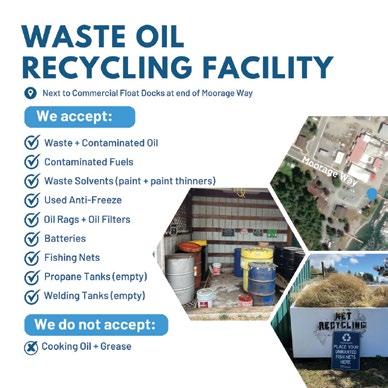
ATTENTION:
AFTER-HOURS
HOUSING & UTILITY EMERGENCIES


10
Larsen Visits didgwálic
U.S. Rep. Rick Larsen met with Chairman Edwards, Senator Wilbur, and didgʷálič staff for a tour of the wellness center at the end of March. He spoke with didgʷálič staff about the whole-person approach to treatment the center takes, and spent time with Chairman Edwards and Senator Wilbur discussing the plans and needs of Swinomish.
Keyes opened the tour by sharing that “when you start doing treatment, we will help you every step of the way”. In addition to services such as transportation and child care, their whole-person approach includes services not typically offered like dental and Hepatitis C treatment.
Larsen is currently co-sponsoring legislation that would move forward combating the opioid epidemic, including a bill that would allow tribal officers to enforce federal law under specified circumstances. However, as Senator Wilbur stated, “We aren’t going to arrest our way out”, highlighting the need to approach the epidemic through multiple avenues.
In his recently published report “The Opioid Crisis in Washington’s Second Congressional District and a Comprehensive Solution”, Larsen would seem to agree. In it, he outlines a way forward through four pillars; prevention, interdiction, treatment, and recovery. In addition to supporting legislation in these areas he shares changes that could be made to increase access to treatment.
Currently, people experience barriers that include a lack of space in treatment programs, and an inability to receive medication for opioid use disorder (MOUD) in rural areas due to regulations on administration.

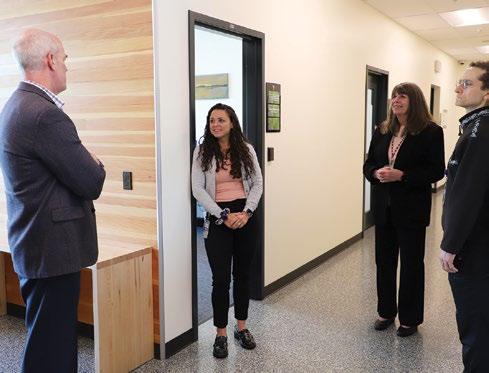
speaks with Lead
SUPD,
Opioid overdoses have increased with the influx of fentanyl in the illicit drug supply. The Skagit County Sheriff’s Office reported 18 overdoses, including three deaths, in a three week span at the beginning of this year.
Larsen
Counselor Rachelle Bellefleur,
while CEO Beverly Keyes and CMO Bryce Parent listen. Bellefleur shared with Larsen how her role in working with pregnant clients extends far beyond the walls of didgwálič.
Senator JJ Wilbur, Rep. Rick Larsen, Chairman Steve Edwards
11
Deputy Attorney General Meeting
In early March, Swinomish Senate and staff members met with Deputy Attorney General Monaco from the U.S. Department of Justice. The meeting recognized the Northwest Safe Trails Task Force, and the grant funded Special Assistant United States Attorney (SAUSA) program. These are collaborative efforts between federal and tribal justice systems to combat violent and drug-related crimes in Indian Country.
Northwest Safe Trails Task Force
The FBI began what is now the Safe Trails Task Force in 1994 as Operation Safe Trails. There are currently 22 of these task forces spread across Indian Country, with over 100 dedicated FBI officers. Swinomish’s participation began in the early 2000s and is one of five tribes in the Northwest Safe Trails Task Force along with Tulalip, Lummi, Nooksack, and the Upper Skagit Tribes.
Participation in the Task Force offers Swinomish many resources, including:
‣ Moving violent crimes out of the Swinomish Tribal Court into the federal court.
‣ Federal sentencing and probation.
‣ Intertribal resource sharing.
‣ Access to an FBI victim specialist.
‣ Training opportunities for the Swinomish Police Department.

Swinomish Police Chief Earl Cowan reported during the meeting that Swinomish has an incredible partnership with the FBI agents from the Safe Trails Task Force who have assisted in investigating crimes and executing search warrants. This partnership has been critical when, at the moment, the Swinomish Police Department does not have its own dedicated investigator.
Special Assistant United States Attorney
The SAUSA collaborates with the Swinomish police department, other tribal police departments, and federal law enforcement partners such as the FBI, DEA, and BIA to bring federal charges against those who commit violent and drug-related crimes at Swinomish, Tulalip, Lummi, Nooksack, and the Upper Skagit Tribes.
The SAUSA is a grant funded position. Swinomish was first awarded a funding grant in 2019 and received another in 2023. Funding this position increases the capacity of the U.S. Attorney, and allows for more crimes to be prosecuted at the federal level.
In the press release for the latest grant, shared in the December 2023 qyuuqs, Senator Brian Porter stated that “ The Safe Trails Special Assistant United States Attorney is a key component in our partnership as they will be able to work directly with our federal and tribal law enforcement to bring cases in federal court. We applaud the efforts and partnership with the United States Attorney’s Of fice for the Western District of Washington”.
Relationships
During the meeting, Chairman Edwards remarked that the tribe has come a long way in the last 20 years in developing partnerships with federal law enforcement. He was pleased with the current relationship, and that the Swinomish Police Department is able to call the tribe’s FBI liaison at a moment’s notice when needed.
Senator J.J. Wilbur commented, “Swinomish is thankful for all the resources the Deputy Attorney General’s office has committed to not just Swinomish, but all of Indian Country. Including assisting us in the Maverick gaming lawsuit and their commitment to help defend tribal sovereignty.”

12
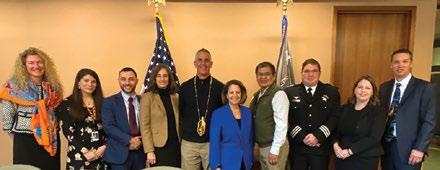
United States Attorney Tessa Gorman
Assistant United States Attorney Michael Harder
Assistant United States Attorney Jocelyn Cooney (Choctaw)
Swinomish Attorney Rachel Sage
Swinomish Senator JJ Wilbur
Deputy Attorney General Lisa Monaco
Swinomish Chairman Steve Edwards
Swinomish Police Chief Earl Cowan
Swinomish Attorney Melissa Simonsen
Assistant United States Attorney Tate London (Tlingit/Raven)
Swinomish Teacher Certification
The Office of the Superintendent for Public Instruction’s (OSPI) First peoples’ language, culture, and oral traditions certification allows tribes to certify their own teachers, under their own certification process, making them eligible for a Washington state teacher certification.
Swinomish is currently in this process to certify the Tribe’s Between Two Worlds and Lushootseed educators in the La Conner School District. Certification will eliminate the need for a certified teacher or ‘teacher-of-record’ to ‘coteach’ the existing Lushootseed language and Between Two Worlds classes, as Swinomish’s teachers are not currently certified. This certification will continue to provide, and potentially expand, relevant and culturally appropriate instruction to Swinomish students in the La Conner School District. The goal is for the process to be completed by the 2024-2025 school year.

13

Update #21 - Olympic Pipeline Gasoline Spill, Conway
April 2 - Spill responders have completed the emergency response to the December 10, 2023 gasoline spill from the Olympic Pipeline in Conway. The Unified Command leading the operation has ensured that no additional gasoline is seeping into nearby Hill Ditch, and is confident in turning the site over to the Washington Department of Ecology’s Toxics Cleanup Program who will oversee any remaining remediation work.
The Unified Command includes the U.S. Environmental Protection Agency, Washington Department of Ecology, the Swinomish Indian Tribal Community, Lummi Nation, Skagit County Department of Emergency Management, and bp who operates the Olympic pipeline. With the conclusion of emergency response operations, the Unified Command has disbanded.
“On behalf of bp, I’d like to express my appreciation to the community of Conway for their patience and support as we worked to respond to the incident. We also thank responding agencies and crews who worked diligently to clean the area. We deeply regret that the incident happened,” said Terry Zimmerman, Incident Commander.
“I would like to acknowledge the responders’ efforts to contain the spill and mitigate impacts to the environment and nearby community. I am grateful for the understanding shown by the community of Conway during the response effort,” said Monica Tonel, EPA On-Scene Coordinator.



“This phase marks an important end to a long, complicated response,” said Madeline Fritzen, State OnScene Coordinator. “I want to thank all the responders who have put in long hours over the last several months. That said, there is still more work to do, and the Department of Ecology will be here until the job is done.”
“I am grateful for the team effort put forward during the response phase by numerous tribes, local, state, and federal agencies,” said one of the Tribal On-Scene Coordinator Keri Cleary. “The coordination between so many different entities during clean-up was impressive. It was a very positive experience in how unified command should work during an event, and we all learned a lot. Everyone made sure that tribal representation was present and their concerns were heard from day one.”
“I would like to thank all the first responders, agencies, and County staff from Emergency Management, Public Health, and Public Works, involved with the Unified Command for their hard work and long hours spent responding to the spill,” said Julie de Losada, Local On-Scene Coordinator. “We are grateful to have such a knowledgeable team behind the cleanup and we look forward to seeing the remediation process completed.”
Updates
‣ Approximately 21,168 gallons of gasoline was determined to have spilled, with 8,324 gallons of gasoline recovered.



14
‣ 332,776 gallons of oily water was recovered and disposed of.
‣ Nearly 1.1 million gallons of water was treated for contamination and returned to Hill Ditch.
‣ 11,973 cubic yards of soil was removed from the affected area.
‣ The cofferdam has been removed following the removal of contaminated soil along the bank of Hill Ditch.
‣ Sampling downstream of the spill site has shown no concentrations of gasoline-related contaminants harmful to humans, pets, or the environment since January 19, 2024.
‣ Nearby residential wells have shown no indication of contamination.
‣ Approximately 21,168 gallons of gasoline was determined to have spilled, with 8,324 gallons of gasoline recovered.
‣ 332,776 gallons of oily water was recovered and disposed of.
‣ Nearly 1.1 million gallons of water was treated for contamination and returned to Hill Ditch.
‣ 11,973 cubic yards of soil was removed from the affected area.
‣ The cofferdam has been removed following the removal of contaminated soil along the bank of Hill Ditch.
‣ Sampling downstream of the spill site has shown no concentrations of gasoline-related contaminants harmful to humans, pets, or the environment since January 19, 2024.
‣ Nearby residential wells have shown no indication of contamination.


15
Salmon in the Classroom
DEPARTMENT OF ENVIRONMENTAL PROTECTION
The Skagit Fisheries Enhancement Group delivered 200 coho eggs to the Between Two Worlds Indigenous Science Program in early January. A science class developed by the Swinomish Department of Environmental Protection, the Between Two Worlds (BTW) Program and operates at the La Conner High School for both Swinomish and non-Native students alike.
This year, BTW teamed up with the second grade class to host Salmon in the Classroom, an educational program that teaches students about the life cycles of salmon, habitat, and water quality. BTW students helped with maintaining the tanks, raising the eggs from hatching to the fry stage, and then releasing them when they were 16 weeks old. This program culminated in the release of juvenile salmon on March 20, at Hansen Creek in Sedro Woolley.
We were excited to be able to support this opportunity in the school and watch these little salmon grow!


16
January 25 - The first egg hatched into the alevin stage!
FITNESS + COMMUNITY = LIFESTYLE MEDICINE
One element of balanced mental health is having a sense of community. Reaching out to friends and love ones who might need your support during tough times and being open to receiving support when you need it most are vital elements of our collective mental wellbeing.
Similarly, when it comes to being active or establishing an exercise routine, having a community of like-minded people who share and/or support your goals is a primary factor in predicting long-term success.
So, why not couple those two objectives, community and physical activity, and join with others on a pursuit of physical wellness, providing each other with emotional support and a sense of togetherness as you all move around? Social support provides camaraderie, accountability and motivation, and can make physical activity more enjoyable and rewarding.
Regular exercise improves mental health:
‣ PRODUCES NEW BRAIN CELLS: Physical activity elevates the production of neurotransmitters that can stimulate the production of new brain cells.
‣ IMPROVES BRAIN FUNCTION: Learning how to do new things, such as a new sport or exercise, can improve cognition and mental acuity.
‣ SUPPORTS A POSITIVE SELF-IMAGE: Exercise can boost your self-esteem by offering a sense of achievement and success.
‣ ENABLES BETTER SLEEP FOR A BETTER YOU: Being physically active can improve sleep quality, which is vital, as insufficient sleep has been linked to the development of chronic conditions, as well elevated stress levels and weight gain.
GIVES YOUR MIND A BREAK FROM ROUTINE:
Taking time out to do things for your own physical and mental well-being is essential. Many people with anxiety or depression use exercise as a positive coping mechanism.
‣ RECEIVE POSTIVE IMPACTS OF TOGETHERNESS: Exercising with a friend or two, as a couple, or part of a group – or simply going to a gym is an opportunity to engage, make new friends, and participate as a community.
You can enhance the benefits by:
‣ GOING OUTSIDE: Getting outside do something physical can decrease feelings of tension and anger. It is also a great way to get vitamin D, which can help with the management of depressive symptoms. Exposure to nature is linked to stress reduction, improved mood, and enhanced cognitive function.
‣ INCORPORATING MINDFULNESS: Incorporating mindfulness into your routine can help with mental health. It can take many forms, including such activities as yoga, qigong, walking, running, cycling, and rowing, all of which can be made more mindful if you focus on the repetitive movement, your breathing, and how your body feels as it moves through space. Meditation, prayer, and breathing exercises are also options.
‣ EMBRACING GRATITUDE: Embracing a sense gratitude can be magic for your mental health. Think of exercise as a celebration of all that you are capable of. Every successful step along your journey, even if it is just one more completed yoga class, an extra five minutes walked, or two more sit-ups, is worth celebrating —and celebrating with friends just makes it that much better.
17
Nourishing A Dream
LINDY HUNTER AND COURTNEY GREINER, FISHERIES DEPARTMENT
She had a dream; a dream that in seven generations her distant grandchildren, nieces, nephews, and all those in between could take part in the fishing traditions of her ancestors. Climate change has complicated this vision and the busy hum of life has blurred the path of traditional knowledge in ways that make it harder for some to follow. In the face of these obstacles, the dream of our former fisheries manager will be hard to reach, but she never gave it up and neither will we. Overcoming obstacles and nurturing dreams for the future is where the work of Swinomish Fisheries began and is what we still work towards today.
In the Salish Sea, a dream for future generations to know and practice the traditions of their ancestors is a dream for sustainable fisheries and healthy tidelands. The most recent progress towards this goal is the upcoming publication of a set of climate change adaptation strategies specifically focused on shellfish habitat and populations. The “ Climate Change Adaptation Strategies for Shellfish”, also known as the CCASS, considers the diverse tidelands and waters of the Swinomish people and the shellfish creatures that dwell there. It highlights local climate change adaptation plans that the community can adopt to continue their traditions and maintain livelihoods centered on the Salish Sea. Bringing together research from all over the world, the CCASS outlines the most promising plan for increasing shellfish survival in the face of current and impending environmental changes.
The CCASS presents four adaptive strategies for decreasing vulnerability and increasing the resilience of marine resources within the Salish Sea; clear goals and actions are described with each of these strategies.
These four strategies are: (1) preserve intact, functioning ecosystems, (2) reduce environmental stressors that are not related to climate change, (3) restore environmental processes to promote landscape diversity and functions, and (4) enhance native species and ecosystem diversity.
The CCASS is also a living document and will grow and change as we learn more about the effects of climate change on shellfish and uplift the teachings of knowledge holders. Upcoming issues of the qyuuqs will contain detailed information on each strategy and contain suggestions on how you can help. The entire CCASS will be available soon on the Swinomish Fisheries website: swinomish-nsn.gov/resources/fisheries.
If you can’t wait and want to learn more now, come see us at your newly remodeled Fisheries Department building – we are open!
Climate Change Adaption Strategies for Shellfish Preserve Reduce Restore Enhance

Preserve intact, functioning ecosystems
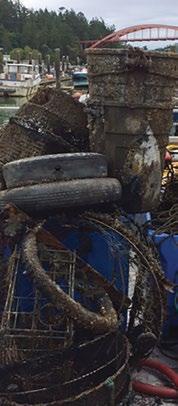

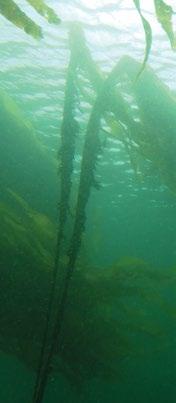
that are not related to
Restore environmental processes to promote landscape diversity
Enhance native species and ecosystem diversity 18
Reduce stressors
climate change
and function
TENDING THE GARDEN
LINDY HUNTER, FISHERIES DEPARTMENT
As the frogs and trillium began to usher in spring, we said goodbye to the winter night tides and wrapped up the year’s final moonlit tending event on the clam garden. Introductions and sharing of stories were cut short as the clouds opened up and sent us all scurrying for cover. Fortunately, the downpour was short lived and by the time we had filled our bellies with warm clam chowder, fresh bread, and hot apple cider only a light drizzle and some heavy mist remained to join us for low tide.
Tending is an important part of building and caring for any garden, both for the critters that live there and for the creatures like you and me who stop by to enjoy it. Traditional clam gardens are ancient places and ancient places are built on the bits and pieces of those that came before. As we build up our modern clam garden, one of the main tending tasks is to put shell on the beach. This adds diverse structure and essential minerals and nutrients to the clam habitat in the same way that the remains of abundant shellfish populations did on ancient gardens. Practically speaking, this means smashing a truck load of oyster shell into small pieces, and carrying it bucket by bucket to spread onto the beach. Turning the beach is another important task. Using a clam fork to turn and loosen the top layers of sand allows oxygen and food to move slightly deeper into the beach, and increases the area that clams of all life stages can thrive in. The more hands the better for this type of hard work and we were pleased to have so many helpers.
Participating in these activities and working together is a worthy endeavor. Tending work builds up and strengthens the habitat within the clam garden but it can also strengthen connections within ourselves, between us and the beach, and with each other; reminding us that we are part of the garden and the garden is also part of us. We are grateful to the community members who joined us on this crispy winter night to tend to the garden and share of themselves and their knowledge. Thank you!
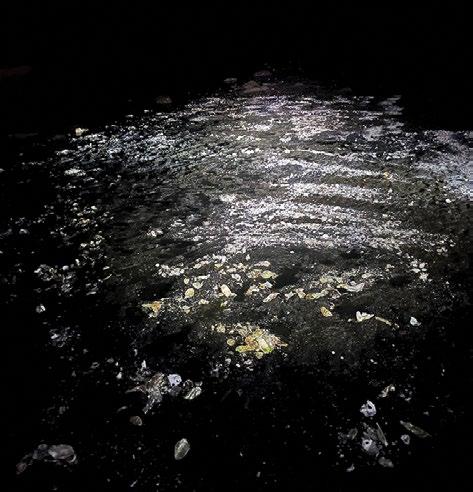
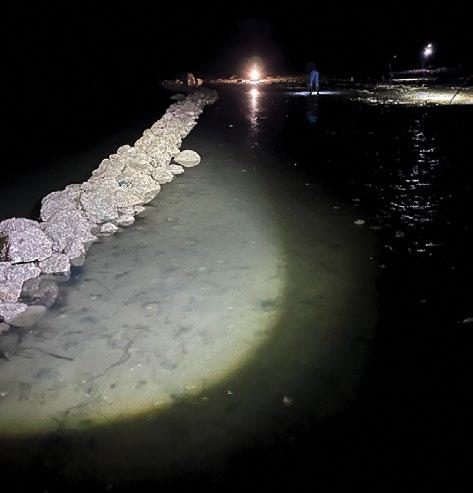
19
POLLINATORS
SARAH KELLOGG, SWINOMISH COMMUNICATIONS
Pollinator Week, which will be June 17-23, is a celebration of the birds, bats, beetles, bees and other insects, and small mammals such as mice that play an incredibly important role in the ecosystem and to food production. The Xerces Society for Invertebrate Conservation estimates that more than two-thirds of the world’s crops rely on pollinators. They also share that over 85% of flowering plants worldwide rely on pollinators, and consider them to be a keystone species in many terrestrial ecosystems. A relationship of mutualism, both the plants and pollinators benefit. The plants are fertilized, and the pollinators receive a meal of pollen or nectar.
Who are some of our pollinators?
With approximately 3,600 bee species native to the United States and Canada, bees are perhaps the most recognizable of pollinators. There are two different types of bees; social bees and solitary bees. Bumblebees and honeybees are social bees. They live in hives, make wax and honey, and have stingers. Although social bees are more well-known, solitary bees make up 90% of the bees in North America! Unlike social bees, female solitary bees create nests for their eggs and leave pollen for their offspring. Mason bees, leaf cutters, and sweat bees are only a few of the solitary bee species.
Flies are another common pollinator, estimated to be second only to bees world-wide. They can be found on plants with a strong odor – the stinkier better! Western skunk cabbage is, perhaps unsurprisingly, one of their favorites.
Hummingbirds are Washington’s feathered pollinators. They are attracted to red, orange, purple, pink, and white flowers. With their long tongues, they are able to reach the nectar of tubular flowers like honeysuckle, and also enjoy other native plants like rhododenrons and columbines. Rufous hummingbirds, which are migratory, rely on early spring blooms as they make their way north.
Beetles are one of the most diverse groups of animals on the planet with over 300,000 known species worldwide. They can be found pollinating a variety of flowers, including Pacific dogwood, asters, and goldenrod. Beetles were the first pollinators, and have ancient associations with magnolia. Common pollinator beetles in the Pacific northwest include long-horn beetles and checker beetles.

beetles and flies, which it attracts with its strong-smelling odor.
Western skunk cabbage (Lysichiton americanus) is pollinated by
20
Brightly colored flowers in red, purple, orange, yellow, pink, and blue are attractive to butterflies. They prefer flat-topped flower clusters that offer a stable landing pad, and also seek out flowers that provide shelter for eggs and food for larvae. Milkweed, yarrow, and lupines are just a few of their native favorites.
Bats and moths are the “night shift” pollinators. With only the light of the moon to show the way, they are attracted to strongly scented plants such as honeysuckle, and lightcolored flowers like that of yarrow. Bats in the Pacific Northwest are not pollinators, however in tropical and desert climates they pollinate fruits such as mangoes and bananas, and plants such as the agave.
Why are they in danger?
Habitat loss, pesticides, and climate change are all dangers to pollinator populations. Habitat loss occurs as more and more land is developed and plant diversity decreases. Grass lawns and non-native plants compete with native plants and in some cases will outcompete them. Hybrid and cultivar plants used in gardens may be sterile and not develop the pollen that pollinators need.

Cuckoo Bumble bees



Striped Bumble Bees








Climate change has made summers warmer and dryer, and has shifted the seasonal changes. Rainfall and winter precipitation has also been affected. Pollinators rely on cues from things like temperature and rainfall to emerge, and are now out of sync with the plants that they pollinate.
The USDA shares that plants are now blooming on average eight days earlier than in 1951. Extreme heat events are also a danger. With their high metabolism and food requirements hummingbirds, for example, are greatly affected by these events. If they are forced to rest due to extreme heat, they can starve to death. As a result, their range has started to shift to higher altitudes.
While all pesticides are a danger to pollinators, neonicotinoids (or “neonics”) are a type of insecticide that have been linked closely to bee death and pollinator decline. Neonictinoids are a “systemic”, which means that it is absorbed by the plant and makes all of the plant (including pollen) toxic to anything that eats it. This not only includes adult pollinators but also the juveniles who feed on leaves and other parts of the plant.
Red on the Body?












Black Tailed Bumble Bees




White on the body?




E W High Elevation Conservation Concern S
PNW Bumble Bees (Bombus spp.) - Females
B. appositus
B. franklini
B. occidentalis
B. sitkensis
B. flavidusB. insularis B. suckleyi
B. bifarius B. centralisB. flavifrons B. huntii
B. mixtusB. melanopygusB. rufocinctus B. sylvicola
B. bifarius B. caliginosus B. fervidus
B. melanopygus B. rufocinctusB. sylvicola
B. vandykeiB. vosnesenskii
B. nevadensis B. morrisoni
B. impatiens
B. griseocollis
B. flavifons
B. vagans
B. fervidus
Bumble bee illustrations: Paul Williams (identification and color patterns) and Elaine Evans, Rich Hatfield (bee body design).
21

Rufous hummingbirds are one of two species that live in Washington's lowlands. Rufous are migratory and spend their winters in Mexico.
What you can do to help?
Skip the bug zapper! Studies are beginning to show that they aren’t great at controlling mosquitoes, but they do kill moths and beneficial insects.
Don’t use pesticides. If you need to use them, do so responsibly. The use of pesticides, including neonictonoids, on live plants sold at stores is declining, but something to still watch out for. Purchasing plants from a local nursery is a great way to avoid them - often, the employees will know if their plants have been treated or not.
Plant a pollinator garden! A pollinator garden should have a variety of grasses, trees, shrubs, and flowers. Flowering plants should be diverse in colors, shapes, and bloom periods to provide food sources to pollinators from early spring to late summer. Skip the butterfly bush (Buddleia species) – it is not native to North America, and in some areas is even considered to be a noxious weed. Stick to native plants, as much as possible. Locally-owned nurseries often have native plants available, and some Washington Native Plant Society chapters have native plant fundraising sales in early spring.
There are many resources and local organizations with information about which plants work well in pollinator gardens for our region (see the next page). The Xerces Society for Invertebrate Conservation, the Pollinator Partnership, and the Washington Native Plant Society are all places to start. Some of these organizations also have resources on pre-mixed pollinator seed packets which are a great, easy, and an often inexpensive way to get started on your pollinator journey.
Gardeners and those with yards can preserve pollinator habitat by not disturbing leaf and plant litter while bees are overwintering. Most of our native bee species build their nests underground. Some of those rely on ground nesting mammals (such as rodents) for their habitat, and might overwinter in abandoned nests.
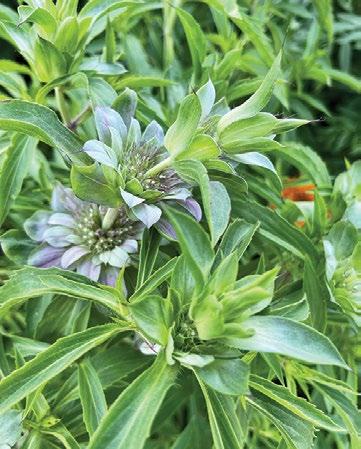 Monarda, also called bergamot or bee balm, is a pollinator favorite.
Monarda, also called bergamot or bee balm, is a pollinator favorite.
22
Planting Guide for your native pollinator garden
Use the arrangement below to have a continuous garden - spring, summer, & fall



BLOOM SEASON For best results, use multiple plants of each species.





Follow these steps to create your beautiful native pollinator garden
1 Identify your garden spot:
Find a 3’ x 6’ plot that gets 6+ hours of sun. Have a larger area? Include more choices and clump the same species together.
Remove or smother existing lawn or vegetation. Enhance hard-packed soil with organic compost.
3 Plant!

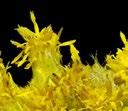


NORTHWEST REGION
BLOOM SEASON NATIVE PLANT OPTIONS
2 Buy plants at a local native plant nursery, if possible. Remove the plant from the pot, loosen the roots, place it in the hole, backfill, tamp soil, and water.
Arrange plants with different seasonal blooms in your plot. Dig holes twice as large as each plant’s pot.
Mulch plot to depth < 1 inch, keeping mulch away from stems and avoid using hardwood chips and shreds.
4 Maintain your garden:
Water to keep moist throughout the first two weeks, then as needed or when plants droop. Weed as needed.
Avoid using insecticides, herbicides, or fungicides.
Be patient - your garden may take a few years to fully establish and fill in!



6’
3’ Spring Summer Fall
Douglas aster walter siegmund
Oregon sunshine krzysztof zarnek
redflower currant krzysztof ziarnek
West coast goldenrod john rusk
common yarrow anemone projectors
mountain monardella jim morefield Western coneflower rhododendrites
NORTHWEST REGION ID, OR, WA
Oregon grape salicyna showy milkweed peganum
Add
Photo credits on reverse side of card.
your garden: www.millionpollinatorgardens.org
Your state’s native plant society can recommend additional locally appropriate native species. See North American Pollinator Protection Campaign Ecoregional Planting Guides for additional information: www.pollinator.org/guides color dots above indicate bloom color SEASON West of the Cascades East of the Cascades Spring common yarrow Achillea millefolium wax current Ribes cereum Oregon grape Mahonia (Berberis) aquifolium common yarrow Achillea millefolium redflower currant Ribes sanguineum threadleaf phacelia Phacelia linearis common Summer showy/narrowleaf milkweed Asclepias speciosa A. fascicularis showy/narrowleaf milkweed Asclepias speciosa A. fascicularis Oregon sunshine Eriophyllum lanatum sulphur buckwheat Eriogonum umbellatum mountain monardella Monardella odoratissima scarlet gilia Ipomopsis aggregata mountain monardella Fall Western coneflower Rudbeckia occidentalis rubber rabbitbrush Ericameria nauseosa West coast goldenrod Solidago elongata Canada goldenrod Solidago canadensis Douglas aster Symphyotrichum subspicatum common sunflower Helianthus annuus western coneflower
ID, OR, WA yarrow 23

Mason Bee Houses
Mason bees are a native solitary bee that are far more efficient pollinators than honeybees. Creating a mason bee house is one way that people can support our native bee populations. Here are some tips from Crown Bees, a bee-devoted company in Issaquah, for making a habitat.
Natural, untreated wood is best. You can also build a container house with items around your home. Some examples include milk cartons, plastic buckets, and cut PVC pipes. Make sure you poke a few air vents in the sides or bottom of the container to prevent mold and provide an overhang to protect the nest materials from rain.
Something to remember when collecting nesting materials is that different bee species use different diameter nesting holes. Spring mason bees prefer ≈8 mm diameter holes, while summer leafcutter bees prefer ≈6 mm diameter holes. Or, place various sizes in your bee house to see what wild cavity-nesting species live in your area! Below are some favorite types of nesting materials to use – mix and match to give your house a unique look!
‣ Natural, plant-based reeds/stems are the most attractive to bees. Reeds can be store-bought or harvested from nature. They should open easily for quick removal of cocoons. Most reeds have a natural node to seal the back end. If they do not, make sure you close the back before placing them in your house - clay works as a suitable tube sealant.
‣ Avoid Bamboo: A commonly promoted reed for bee houses; however, bamboo is difficult to open, which could damage cocoons in the process and is typically too large of a diameter for many cavitynesting bee species.
Paper tubes are the most economical choice of nesting materials. They are lightweight and easy to open for quick removal of cocoons. An alternative to purchasing paper tubes made explicitly for mason bees is paper straws. Just make sure you seal the back end of each straw before placing it in your hotel - clay is a natural substance that works as a suitable tube sealant.
‣ Avoid Plastic Straws: Plastic straws can’t be reused, recycled, or broken down organically - adding to the waste problem.
While bees don’t care how expensive their house is, they’re picky when it comes to their home location. Houses should be:
‣ Mounted to a solid object (like a post, house, or fence). Bees don’t like swinging in the breeze!
‣ Placed in a location facing south or southeast to receive direct sunlight in the morning. They are coldblooded and need the morning sun to start moving.
‣ Near open blooms and a mud-rich clay. Many wild bees only fly about 300 feet searching for nectar and pollen, and some species, like mason bees, use mud-rich clay to build their nests. Place the house near flowers and a mud-rich clay source, or risk your bees flying off in search of a better home.
‣ In a location free of pesticides.
Maintenance is often the most overlooked part of having a bee house. Routine maintenance is just as essential as proper design! If you don’t clean and maintain your bee house and nesting materials, they can harbor pests and diseases, putting local bees in more danger than if there was no house at all. Throughout the summer, monitor for the following problems:
‣ Moisture in the bee house or nesting materials - you may need a broader roof on your bee house.
‣ Ant infestations.
‣ Evidence of predatory birds.
‣ Spider webs - indicates the nest location may be too dark.
A mason bee in a man-made house.
24
The Pollen, the Bee, and the Hive
Honeybees are fuzzy and carry an electrostatic charge that makes pollen grains stick to their bodies. Some types of bees actually carry pollen in a tiny basket located on their hind legs.
Wild bees live in hives that usually have only one entrance. The hives are made up of wax called honeycombs that store honey and house the baby bees, or larva. Bees have many different jobs. Some work inside the hive while others work outside. A beehive has one queen bee that creates all the baby bees and is served by hundreds of male bees and thousands of female worker bees that clean the hive, feed the larva, and gather the pollen.
Did You Know?
There are 20,000 known species of bees. Honeybees are the only insects that produce food for humans. Bees fly an average of 13 to 15 miles per hour. Queens will lay almost 2,000 eggs a day at a rate of 5 or 6 a minute. Between 175,000 and 200,000 eggs are laid per year.
The queen bee has lost her way. Can you guide her through the hive?
Bee
Pollen Popular
25

Merla Rae Martin, Swinomish Tribe, receiving 2nd in the nation shown with ICC President, Lela Beckwith
26th Annual National Indian Realty Awards
February 26 - The 26th Annual National Indian Realty Awards were presented in Santa Ana, California. The awards were presented to the top 20 Indian land professionals in the nation and the top 15 realty offices.
The Indian Land Professional of the Year was awarded to Darnell Day of the Shawnee Field Office. Ms. Day is a member of the Absentee Shawnee Tribe. Second place goes to Merla Rae Martin from the Swinomish Tribe.
Muscogee Nation, Okmulgee, Oklahoma received the award for Indian Land Office of the year.
Individual awards and land offices awards were presented by Lela Beckwith, President of ICC Indian Enterprises.
Congratulations, Merla Rae Martin!
AIR QUALITY AWARENESS
DEPARTMENT OF ENVIRONMENTAL PROTECTION
May 6-10 is Air Quality Awareness week! Let’s learn about some of the basics of air quality.
Air quality is determined by how much pollution is in the air. Pollutants are particles and gases that can be from anthropogenic (human) sources like vehicles, refineries, wood burning, and even fireworks or from natural sources such as wildfires and volcanoes. These sources all emit pollutants into the air.
Air pollution can have impacts on both human health and the environment. While different air pollutants can have different impacts on human health, many cause respiratory and cardiovascular effects. Air pollutants can also have environmental impacts like contributing to climate change, harm to wildlife, and by causing acid rain.
What are some of the air quality concerns at Swinomish?
At Swinomish some of our top air quality concerns are from particulate matter. We are seeing increased impacts from wildfire smoke during wildfire season. During the winter months, we can have weather patterns that called stagnation events where the air is still and pollution gets trapped near the surface. Particulate matter from residential wood burning can impact air quality during these weather patterns. We even see spikes in particulate matter caused by fireworks during the 4th of July and on New Year’s Eve. Our air quality program has monitors that measure particulate matter in real-time at several locations around the Swinomish Reservation.
Many air pollutants come from industrial sources like refineries. We have an air quality monitoring station near the Swinomish Casino & Lodge, which has instruments that measure ozone, particulate matter, nitrogen dioxide, sulfur dioxide, and hydrogen sulfide. Ozone, nitrogen dioxide, and sulfur dioxide are criteria air pollutants –common pollutants that are regulated by the Federal Clean Air Act.
We also regularly collect air samples to measure hazardous air pollutants (HAPs), which are pollutants known to cause cancer or other serious health and environmental effects. Examples of HAPs we measure include benzene and volatile organic compounds. Our monitoring of criteria and hazardous air pollutants helps ensure that the air quality around the reservation is safe for the health of the Swinomish community and the environment.
What can you do?
The Air Quality Index (AQI) is a scale that uses particulate and ozone pollution to determine daily air quality and potential impacts on public health. Individuals with asthma or other respiratory and cardiovascular concerns may be more sensitive to air pollution, and may experience symptoms like coughing or shortness of breath. You can monitor the AQI and adjust activities depending on the air quality to minimize your symptoms.
Find the AQI at airnow.gov or swinomish-nsn.gov
26

27
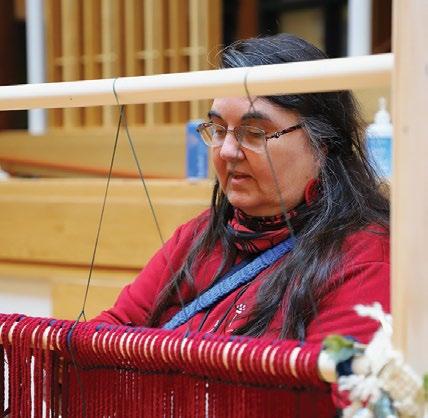

SWINOMISH RECEIVES
LARGE CLIMATE-
FLOOD RESILIENCE AND SALMON HABITAT GRANT AWARD
SUBMITTED BY SWINOMISH ENVIRONMENTAL POLICY
Swinomish was awarded a $701,000 grant this March through the 2023 National Fish and Wildlife National Coastal Resilience Fund for a project titled “Planning for Flood Resilience Capacity and Salmon Habitat Improvement in the Skagit River.”
The Tribe will partner with the Skagit River System Cooperative, Skagit Climate Science Consortium, and University of Washington Climate Impacts Group to develop a revised hydraulic model for the lower Skagit River floodplain to enhance understanding of coastal and riverine flood risks.
“With this grant award, the Swinomish Tribal Community continues its leadership role to advance best scientific information and apply it to the real-world impacts resulting from climate change in order to ensure we can recover salmon while better protecting Skagit communities,” said Tribal Chairman Edwards. “I’m proud that this important project will be carried out by a team of climate experts and that an integral part of this grant is community education, engagement, and outreach.”
The project will build capacity for tribes and local communities to advance nature-based solutions to flooding, salmon habitat restoration, and resilience. This effort will combine inclusive and proven engagement processes with state-of-the-art hydraulic modeling to facilitate conversations about flooding and the implications for public safety, infrastructure, agriculture, and fish habitat within the Skagit River and delta.
Skagit tribes, state and federal agencies, local jurisdictions, and the agriculture community will be key in helping to identify and evaluate solutions that have broader support across diverse interests and stakeholders. Work is planned to begin this year.
WEAVING
Robin Carneen weaving a wool skirt
28
Lenora and Anna Cook with their weaving project


29
Education Dinner for K-5th Grades

 Jayde Torres picks out a book at the book fair
Jayde Torres picks out a book at the book fair
30
Lori and Koa Ngyuen
FREE HAIR CUTS



 Left: Isaias Guzman gives Carey Bobb a fresh cut
Left: Isaias Guzman gives Carey Bobb a fresh cut
31
Above: Kendrick Kaubin with his new hairdo
EASTER EGG HUNT


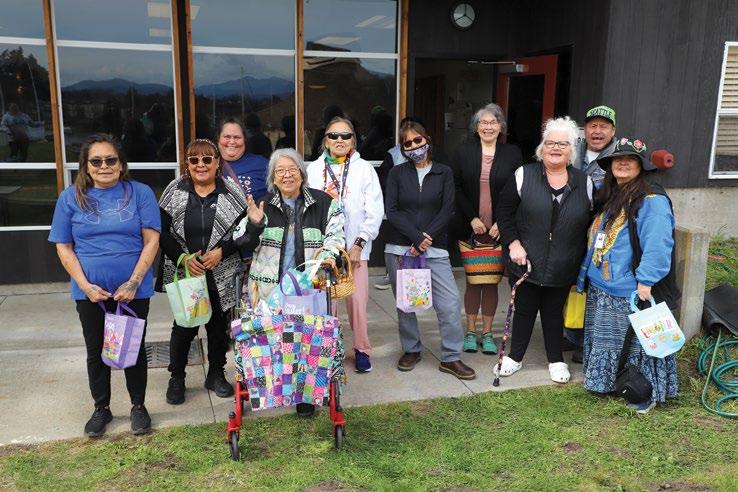 Takeo finds the golden egg for the middle school age group
Lucetta showing off money found in one of her eggs
Takeo finds the golden egg for the middle school age group
Lucetta showing off money found in one of her eggs
32
Elders turn to hunt for eggs!
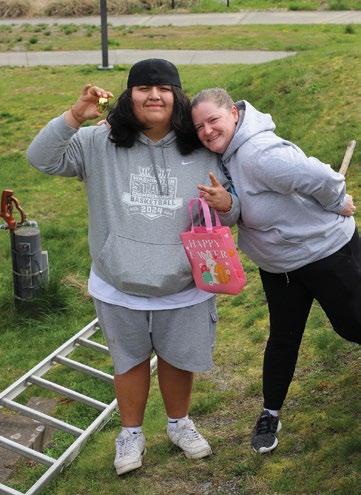


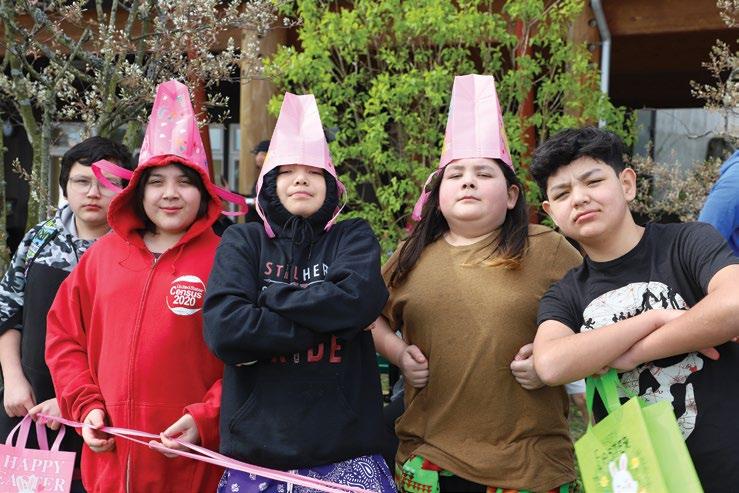 Chas showing off the golden egg Mandy hid
Paisley, Tyee, and JuJu pose with the Easter bunny
Chas showing off the golden egg Mandy hid
Paisley, Tyee, and JuJu pose with the Easter bunny
33
Jayce, Jaylen, Isaac, Kayleb, and Zaine waiting for the hunt to start
Excluded From the Swinomish Reservation
VIOLATION OF AN EXCLUSION ORDER IS A ‘CLASS C’ CRIMINAL OFFENSE. IF ANY OF THESE INDIVIDUALS ARE SEEN ON THE RESERVATION, CALL 911.
Website: Swinomish.nsopw.gov
EXCLUDED
FROM THE SWINOMISH RESERVATION
EXCLUDED FROM THE SWINOMISH RESERVATION
EDWARD JOSEPH FORNSBY
DALE DUPRE CASEY
DALE DUPRE CASEY

MALE DOB 12/02/69
MALE DOB 12/02/69
HGT: 6’02” WGT: 180 (WARM SPRINGS)
6’02” WGT: 180
SPRINGS)
ORDER EFFECTIVE 12/02/2015
EFFECTIVE 12/02/2015
KIMBERLY JO JOHNSON
KIMBERLY JO JOHNSON

FEMALE DOB 11/02/67
5’02” WGT: 134
5’02” WGT: 134
NOOKSACK
ORDER EFFECTIVE 04/09/2018
EFFECTIVE 04/09/2018
DAVID ALLEN PEACHER
DAVID ALLEN PEACHER
JAMES MICHAEL CLARK
JAMES MICHAEL CLARK

TREVOR JACK DANIELS


MALE DOB 04/23/91
MALE DOB 04/23/91
HGT: 5’09” WGT: 220 (PUYALLUP)
HGT: 5’09” WGT: 220 (PUYALLUP)
ORDER EFFECTIVE 06/05/2013
ORDER EFFECTIVE 06/05/2013
VICTOR ANTONE
KOCHUTEN
VICTOR ANTONE KOCHUTEN

MALE DOB 09/30/84
MALE DOB 09/30/84
HGT: 5’07” WGT: 195
HGT: 5’07” WGT: 195
ALASKA NATIVE
ORDER EFFECTIVE 05/21/2015
ALASKA NATIVE ORDER EFFECTIVE 05/21/2015
MICHELLE PEREZ
MICHELLE PEREZ

MALE DOB 12/01/61
MALE DOB 12/01/61

FEMALE DOB 09/21/81
FEMALE DOB 09/21/81 HGT: 5’01” WGT: 225
HGT: 5’09” WGT: 185
HGT: 5’09” WGT: 185
ORDER EFFECTIVE 02/25/1991
ORDER EFFECTIVE 02/25/1991
CHRISTOPHER L. ROCHA
CHRISTOPHER L. ROCHA

MALE DOB 03/09/78
HGT: 5’07” WGT: 145
08/21/2007
ORDER EFFECTIVE 08/21/2007
5’01” WGT: 225 ORDER EFFECTIVE 04/26/2016
ORDER EFFECTIVE 04/26/2016
KYLE STURGEON

EFFECTIVE 12/19/13
MALE DOB 08/09/89
MALE DOB 08/09/89
HGT: 5’11” WGT: 180 (CANADA )
HGT: 5’11” WGT: 180 (CANADA )
ORDER EFFECTIVE 06/26/2014
ORDER EFFECTIVE 06/26/2014
LOUIS PAUL MYERS
LOUIS

MALE DOB 01/13/81
MALE DOB 01/13/81
HGT: 5’07” WGT: 186
STILLAGUAMISH ORDER EFFECTIVE 05/21/2005
HGT: 5’07” WGT: 186 STILLAGUAMISH ORDER EFFECTIVE 05/21/2005

HGT: 5’09” WGT: 160 (TULALIP)
HGT: 5’09” WGT: 160 (TULALIP)
ORDER EFFECTIVE 10/30/2013
ORDER EFFECTIVE 10/30/2013
GWENDOLYN GAIL
GWENDOLYN GAIL TOPAUM FEMALE DOB 05/02/72

5’02” WGT: 170
ORDER EFFECTIVE 09/18/2006
MALE DOB 11/15/62
MALE DOB 11/15/62
HGT: 6’00” WGT: 270 (UPPER SKAGIT)
HGT: 6’00” WGT: 270 (UPPER SKAGIT)
ORDER EFFECTIVE 12/26/2012
ORDER EFFECTIVE 12/26/2012
INDIVIDUALS ARE SEEN ON THE RESERVATION, CALL 911.
JORGE OSORIO-RIVERA
JORGE OSORIO-RIVERA

MALE DOB 11/02/81 HGT: 5’02” WGT: 130
MALE DOB 11/02/81 HGT: 5’02” WGT: 130
ORDER EFFECTIVE 04/26/2016
RASHIEM DANEKO
ROBINSON
RASHIEM DANEKO ROBINSON

MALE DOB 03/06/1980
MALE DOB 03/06/1980 HGT: 6’2” WGT: 190
HGT: 6’2” WGT: 190
ORDER EFFECTIVE 03/11/2011
ORDER EFFECTIVE 03/11/2011
KYLE ALEX WALSEY

MALE DOB
VIOLATION OF AN EXCLUSION ORDER IS A ‘CLASS C’ CRIMINAL OFFENSE. IF ANY OF THESE INDIVIDUALS ARE SEEN ON THE RESERVATION, CALL 911.
ORDER EFFECTIVE 04/26/2016
HGT:
HGT:
ORDER
MALE
HGT:
200 LUMMI ORDER
MALE DOB 03/09/78
5’07” WGT: 145
EFFECTIVE
KYLE STURGEON
DOB 10/01/71
6’01” WGT:
HGT:
SAMISH
09/18/87 HGT: 5’9” WGT: 155 CANADA ORDER EFFECTIVE 04/25/2012
HGT:
TREVOR JACK DANIELS
EDWARD JOSEPH FORNSBY
PAUL MYERS
VIOLATION OF AN EXCLUSION ORDER IS A ‘CLASS C’ CRIMINAL OFFENSE. IF ANY OF THESE
MALE DOB 10/01/71 HGT: 6’01” WGT: 200 LUMMI ORDER EFFECTIVE 12/19/13
TOPAUM FEMALE DOB 05/02/72 HGT: 5’02” WGT: 170 SAMISH ORDER EFFECTIVE 09/18/2006
MALE DOB 09/18/87 HGT: 5’9” WGT: 155 CANADA ORDER EFFECTIVE 04/25/2012
KYLE ALEX WALSEY
FEMALE
HGT:
NOOKSACK ORDER
DOB 11/02/67
HGT:
(WARM
ORDER
35




36

HUMAN RESOURCES
For the last open positions, please visit: swinomish-nsn.gov/resources/humanresources

For the latest open positions, please visit: swinomishcasinoandlodge.com/careers/
For the latest open positions, please visit: didgwalic.com
Please submit articles, photos, announcements and celebrations to: qyuuqs@swinomish.nsn.us
37
qyuuqs News
11406 Moorage Way
La Conner, WA 98257
qyuuqs@swinomish.nsn.us
@qyuuqsNews

I AM SWINOMISH. I WILL GRADUATE. SWEEC Preschool class
PRSRT STD US Postage Paid Permit #35 ANACORTES, WA Recyclable Paper OR CURRENT RESIDENT







































































 Monarda, also called bergamot or bee balm, is a pollinator favorite.
Monarda, also called bergamot or bee balm, is a pollinator favorite.




















 Jayde Torres picks out a book at the book fair
Jayde Torres picks out a book at the book fair



 Left: Isaias Guzman gives Carey Bobb a fresh cut
Left: Isaias Guzman gives Carey Bobb a fresh cut


 Takeo finds the golden egg for the middle school age group
Lucetta showing off money found in one of her eggs
Takeo finds the golden egg for the middle school age group
Lucetta showing off money found in one of her eggs



 Chas showing off the golden egg Mandy hid
Paisley, Tyee, and JuJu pose with the Easter bunny
Chas showing off the golden egg Mandy hid
Paisley, Tyee, and JuJu pose with the Easter bunny






















